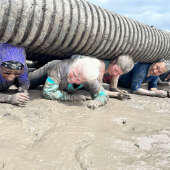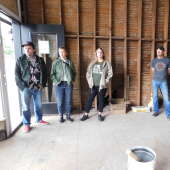More to explore
-

-

-

-

-

-

-
 Local News 5/10/24Cape Girardeau man faces multiple counts of sexual abuse against child3Steven Brown, 32, of Cape Girardeau is being held in Cape Girardeau County jail in lieu of a $250,000 bond while he faces three counts of first-degree sodomy or attempted sodomy on a child less than 12 years old; one count of second-degree child...
Local News 5/10/24Cape Girardeau man faces multiple counts of sexual abuse against child3Steven Brown, 32, of Cape Girardeau is being held in Cape Girardeau County jail in lieu of a $250,000 bond while he faces three counts of first-degree sodomy or attempted sodomy on a child less than 12 years old; one count of second-degree child... -

-

-
 Local News 5/9/24Deceased Cape teacher serves as motivation for Tough Mudder competitor1Tough Mudder is a hardcore obstacle course designed to test participants’ all-around strength, stamina and mental grit, and runners must be at least 14 years old. Mildred Wilson has no problem meeting the criteria. Wilson, 85, was a spry 80 when she...
Local News 5/9/24Deceased Cape teacher serves as motivation for Tough Mudder competitor1Tough Mudder is a hardcore obstacle course designed to test participants’ all-around strength, stamina and mental grit, and runners must be at least 14 years old. Mildred Wilson has no problem meeting the criteria. Wilson, 85, was a spry 80 when she... -
 Local News 5/9/24City of Cape signs lease agreement for police substation on Good Hope10A lease agreement between the City of Cape Girardeau and not-for-profit organization Partners for Good Hope for a police substation at 629 Good Hope St. was approved by the City Council on Monday, May 6. According to the council’s agenda report, the...
Local News 5/9/24City of Cape signs lease agreement for police substation on Good Hope10A lease agreement between the City of Cape Girardeau and not-for-profit organization Partners for Good Hope for a police substation at 629 Good Hope St. was approved by the City Council on Monday, May 6. According to the council’s agenda report, the... -
 Local News 5/9/24Safe Harbor Animal Sanctuary to hold ground-breaking ceremony ThursdaySafe Harbor Animal Sanctuary will hold a groundbreaking ceremony for its new facility Thursday, May 9. The event will be at 10 a.m. at the organization’s location, 185 Cree Lane in Jackson. Plans call for the facility to be complete by January. Safe...
Local News 5/9/24Safe Harbor Animal Sanctuary to hold ground-breaking ceremony ThursdaySafe Harbor Animal Sanctuary will hold a groundbreaking ceremony for its new facility Thursday, May 9. The event will be at 10 a.m. at the organization’s location, 185 Cree Lane in Jackson. Plans call for the facility to be complete by January. Safe... -
 Local News 5/9/24Kiss in gas station parking lot leads to felony weapons charge, documents say9A Cape Girardeau man faces felony charges after police say he used a gun to shatter a victim’s driver’s-side car window. Adam Childers, 37, faces charges of second-degree property damage and unlawful use of a weapon (exhibiting), which is considered...
Local News 5/9/24Kiss in gas station parking lot leads to felony weapons charge, documents say9A Cape Girardeau man faces felony charges after police say he used a gun to shatter a victim’s driver’s-side car window. Adam Childers, 37, faces charges of second-degree property damage and unlawful use of a weapon (exhibiting), which is considered... -
 Local News 5/9/24Cape woman faces Class B felony after allegedly firing weapon during dispute with neighbor4Kylena Fleming, 37, of Cape Girardeau is being held on a $150,000 cash-only bond after police say she fired two bullets toward a victim and then tried to evade officers. Fleming was charged with unlawful use of a weapon, a Class B felony. ...
Local News 5/9/24Cape woman faces Class B felony after allegedly firing weapon during dispute with neighbor4Kylena Fleming, 37, of Cape Girardeau is being held on a $150,000 cash-only bond after police say she fired two bullets toward a victim and then tried to evade officers. Fleming was charged with unlawful use of a weapon, a Class B felony. ... -

-
 Local News 5/8/24Taylor Swift's latest album is resonating with local 'Swifites'It has been almost three weeks since Taylor Swift released her newest album, “The Tortured Poets Department”, on April 19. According to www.billboard.com, the album was streamed over 1.76 billion times worldwide in its first week, breaking the...
Local News 5/8/24Taylor Swift's latest album is resonating with local 'Swifites'It has been almost three weeks since Taylor Swift released her newest album, “The Tortured Poets Department”, on April 19. According to www.billboard.com, the album was streamed over 1.76 billion times worldwide in its first week, breaking the... -
 Local News 5/8/24City council reviews $120M plan to modernize Cape Girardeau’s water systems by 20335The Public Works Department and Alliance Water Resources outlined years worth of improvements needed for the city’s water treatment plant and distribution system to the City Council on Monday, May 6...
Local News 5/8/24City council reviews $120M plan to modernize Cape Girardeau’s water systems by 20335The Public Works Department and Alliance Water Resources outlined years worth of improvements needed for the city’s water treatment plant and distribution system to the City Council on Monday, May 6... -

-

-

-

-

-

-

-
 Local News 5/7/24Cape Girardeau City Council approves million-dollar agreement for water treatment plant lime system4Cape Girardeau City Council members approved a high-density lime system from Chemco Systems L.P. for Cape Rock Water Treatment Plant No. 1 on Monday, May 6, in the “first step” in improvements for the facility and the city’s entire water system. The...
Local News 5/7/24Cape Girardeau City Council approves million-dollar agreement for water treatment plant lime system4Cape Girardeau City Council members approved a high-density lime system from Chemco Systems L.P. for Cape Rock Water Treatment Plant No. 1 on Monday, May 6, in the “first step” in improvements for the facility and the city’s entire water system. The... -
 Most read 5/7/24Cape Girardeau man arrested after allegedly hiding in attic while surrounded by policeA Cape Girardeau man is in jail on two $10,000 bonds after police say the man barricaded himself in an attic for more than an hour while surrounded by police. Jason S. Jones Sr., 44, was charged with the Class A misdemeanor of resisting/interfering...
Most read 5/7/24Cape Girardeau man arrested after allegedly hiding in attic while surrounded by policeA Cape Girardeau man is in jail on two $10,000 bonds after police say the man barricaded himself in an attic for more than an hour while surrounded by police. Jason S. Jones Sr., 44, was charged with the Class A misdemeanor of resisting/interfering... -

-

-

-
 Most read 5/3/24Cape Girardeau Historic Preservation Commission announces 2024 Endangered Buildings list4The 2024 Endangered Buildings List was announced Wednesday, May 1. The list was adopted by the Cape Girardeau Historic Preservation Commission on April 17. According to the commission, the list is “for the sole purpose of promoting public awareness...
Most read 5/3/24Cape Girardeau Historic Preservation Commission announces 2024 Endangered Buildings list4The 2024 Endangered Buildings List was announced Wednesday, May 1. The list was adopted by the Cape Girardeau Historic Preservation Commission on April 17. According to the commission, the list is “for the sole purpose of promoting public awareness... -
 Most read 5/3/24Cape woman faces charges after claims of punching woman, dog during dispute15A Cape Girardeau woman faces charges of animal abuse after allegedly punching a dog that was trying to protect another person during a dispute. The suspect later allegedly resisted arrest and police stunned her with a Taser to get her into a patrol...
Most read 5/3/24Cape woman faces charges after claims of punching woman, dog during dispute15A Cape Girardeau woman faces charges of animal abuse after allegedly punching a dog that was trying to protect another person during a dispute. The suspect later allegedly resisted arrest and police stunned her with a Taser to get her into a patrol... -
 Most read 5/3/24Cape man faces felony after allegedly sending nude image of woman to another man1A Cape Girardeau man is in jail on a $15,000 bond after police say he sent images of a nude woman to another man without permission. Nathaniel James Davis, 33, of Cape Girardeau was charged with the crime of nonconsensual dissemination of private...
Most read 5/3/24Cape man faces felony after allegedly sending nude image of woman to another man1A Cape Girardeau man is in jail on a $15,000 bond after police say he sent images of a nude woman to another man without permission. Nathaniel James Davis, 33, of Cape Girardeau was charged with the crime of nonconsensual dissemination of private...

